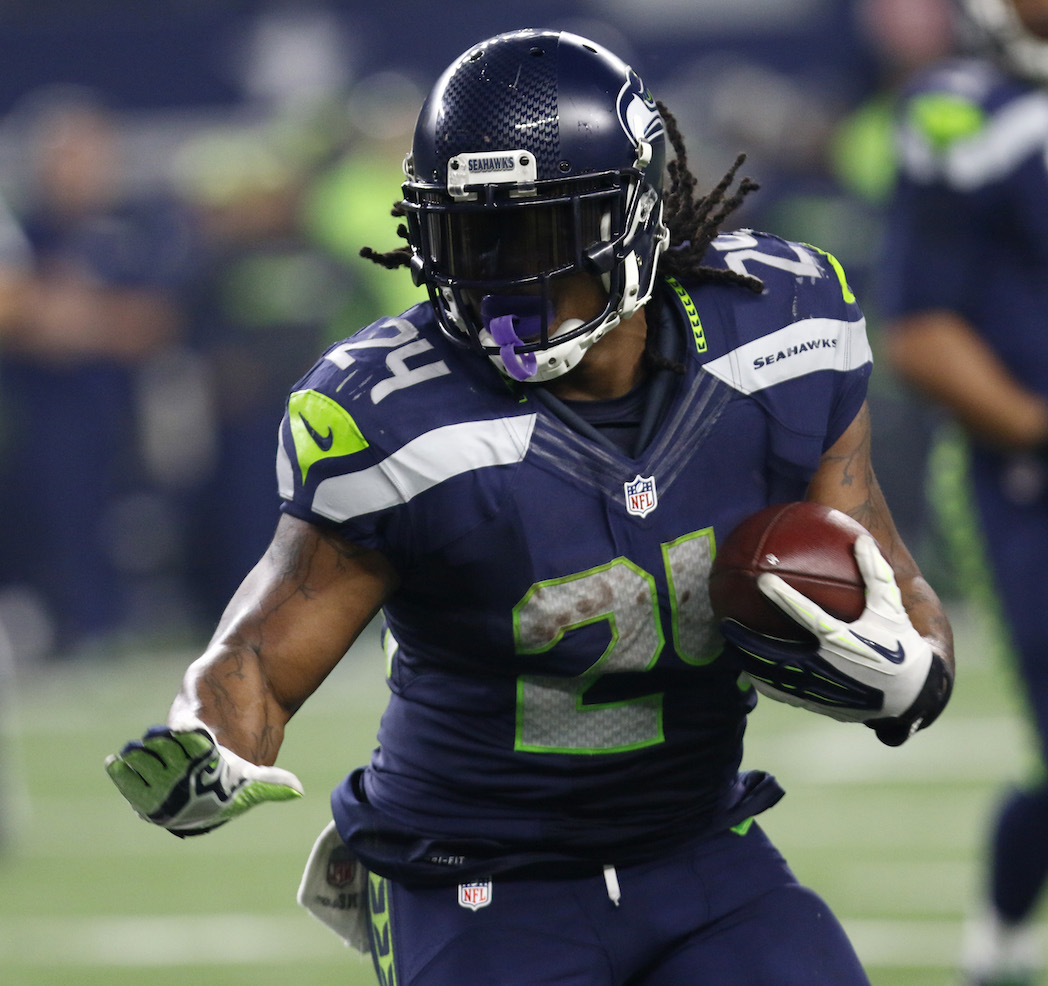Marshawn Lynch made Monday a little sweeter for NFC teams outside of Seattle, with confirmation that he plans to retire. With “Beast Mode's” absence set for 2016, the rest of the football world is left to look back on Lynch’s short—but sweet—nine-year career.
The Cal product went through a range of highs and lows, but ultimately put together a compelling Hall of Fame résumé. Lynch was highly sought-after in the 2007 draft, eventually selected with the 12th-overall pick, but struggled with consistency in Buffalo. A trade to Seattle awoke full on “Beast Mode.” Lynch leaves the league as a Super Bowl winner and the perpetrator of one of the NFL postseason’s best individual plays.
Career overview
| Player | Carries | Yards | Yards per attempt | Yards after contact per attempt | TDs | Broken tackles | Fumbles |
| Marshawn Lynch | 2,337 | 10,058 | 4.3 | 2.8 | 83 | 530 | 20 |
| Adrian Peterson | 2,496 | 12,088 | 4.8 | 3.1 | 102 | 423 | 34 |
Lynch was far from refined as far as running backs go, offering little threat in the passing game and struggling from time to time in pass protection, but he was probably the toughest player to tackle in the entire NFL over the past decade. His 530 broken tackles are testament to that, a good hundred more than “All-Day” Peterson, despite receiving fewer carries than the Vikings’ tailback. Lynch consistently fell forward, finishing his career with a highly respectable 2.8 yards after contact. The outcry over the fateful pass on the final play of Super Bowl IV came, in large part, because of the improbability of stopping Lynch in short yardage, illustrated by an impressive 83 touchdowns.
The other advantage he has over the other likely Hall of Famer (Peterson) drafted five spots above him? Ball security. Turnovers seem inevitable for a player who runs with as much violent purpose as Lynch, but in the end, he put the ball on the deck just 20 times in over 2,000 carries.
The grades tell a similar story to the numbers. Lynch may have fallen just short of bypassing the +100 career cumulative rushing grade mark, but came very close. His +94.7 rushing grade betters Peterson (+84.6) over the same period, and Lynch recorded a better single-season grade than his Canton competitor with a league-leading +28.3 output in 2014.
The news was met with shock this week because it appeared Lynch had so much left in the tank. Perhaps the injuries caught up with him, but it’s a shame to lose such a talented player still apparently capable of producing on the field; in the eight games he played in 2015 (including the divisional playoff), Lynch earned the highest cumulative grade of any RB in the league.
Tale of the trade
Issues off the field—and inconsistency on it—resulted in Lynch’s trade from the Bills to the Seahawks in 2010. Seattle sent a pair of conditional picks to Buffalo, which ended up being a fourth-rounder in the 2011 draft, and a fifth-rounder in 2012. Those picks were used on OT Chris Hairston and LB Tank Carder.
The Lynch trade was undoubtedly won by the Seahawks, who added one of the league’s best backs for a pair of mid-round picks.
Supporting cast
Losing a back of Lynch’s caliber is never a positive, but Seattle appears to have a ready-made replacement in Thomas Rawls, not to mention some much needed cap space to address their offensive line. Rawls had a strong claim for Rookie of the Year before a fractured ankle curtailed his season in Week 14. The undrafted free agent put in some impressive performances on his way to 830 yards from 147 carries (5.6 yards on average), 3.1 yards after contact, four TDs, and 26 broken tackles. Rawls finished the year as our 12th-overall back, despite seeing just 297 snaps. His 85.1 pure rushing grade (scale of 1–100) was fourth behind only Le’Veon Bell, Doug Martin, and Lynch.
Much like his former teammate, Rawls is a little one-dimensional, but he fits Seattle’s prototype on running downs. He isn’t ideal in obvious passing situations, but is a physical runner capable of wearing defenses out. Seattle’s front office clearly has a penchant for backs in the 5-foot-10-inch, 220-pound range; Lynch, Rawls, and 2013 second-rounder Christine Michael all fit that profile. With Michael and Rawls still in place, the Seahawks are set in short yardage and other run heavy sets. However, adding a threat in the passing game would add an extra element to their backfield, making their offense under Russell Wilson even harder to defend.
Lynch’s career will go down as one of the best of the last generation. As defensive fronts became lighter to disrupt the passing game, the Seahawk came into his own. The trail of Saints defenders left by Lynch in the 2010-11 playoffs highlighted his physicality on a national stage, but he had been running with that sort of power every week for a number of years. Eventually that must take its toll.
For the Seahawks, they rode the Beast Mode to a Super Bowl win, and now look ready to move forward with a pair of young backs capable of taking on his mantle.



 © 2024 PFF - all rights reserved.
© 2024 PFF - all rights reserved.